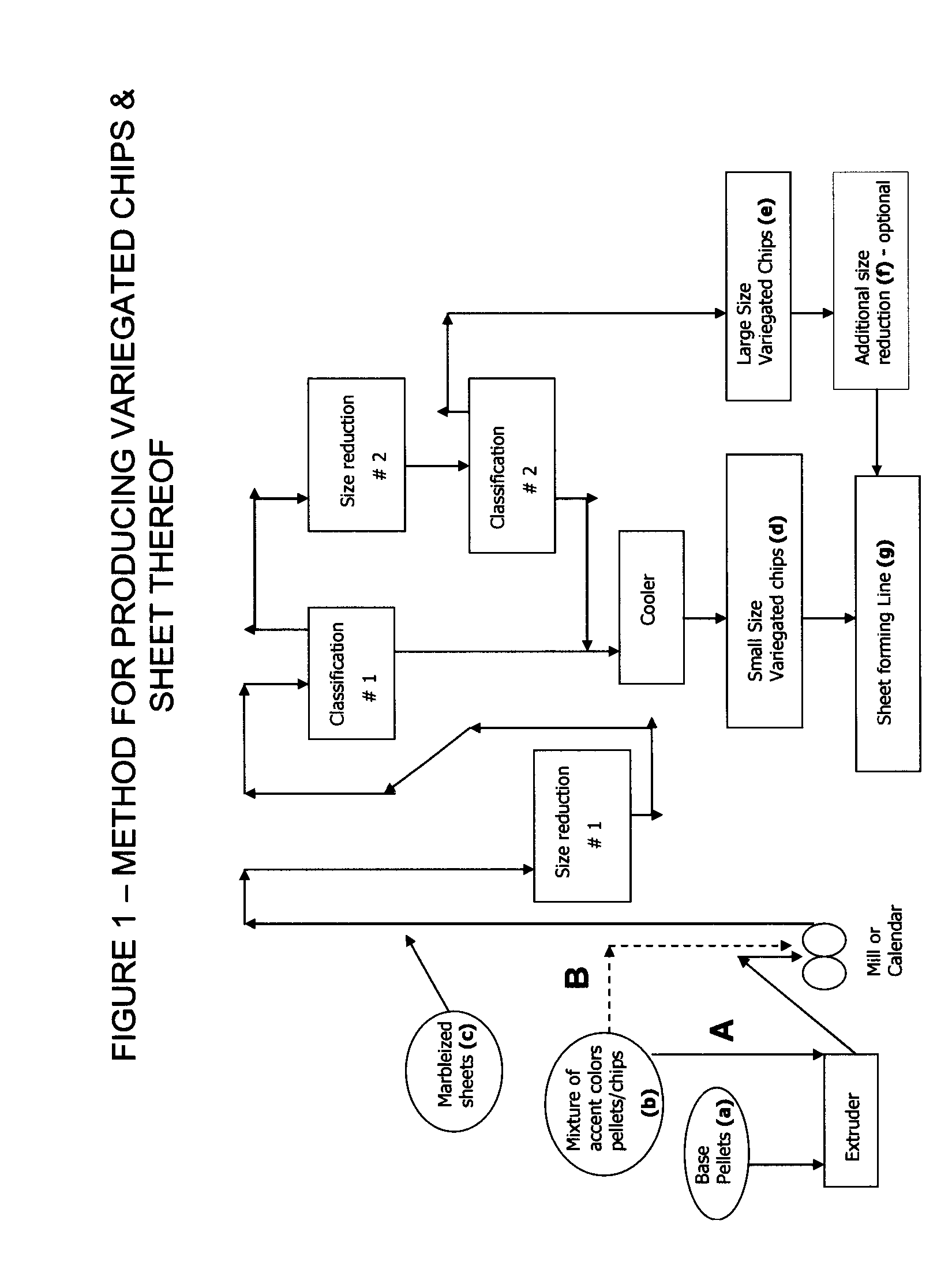Floor Covering Composition Containing Renewable Polymer
- Summary
- Abstract
- Description
- Claims
- Application Information
AI Technical Summary
Benefits of technology
Problems solved by technology
Method used
Image
Examples
example 1
[0189]In this example, blends of ethylene propylene copolymer with an un-modified natural corn starch and a non-genetically modified thermoplastic starch polymer (non-GMO-TPS) are illustrated in Table 1. All components were dried blended and fed into a W&P co-rotating twin screw extruder with all zones set at 200° C., ran at 40 RPM speed follow by sheet forming on a 2-roll calendar with front and back roll temperatures set 300° F. and roll speed at 40 RPM. Sheet thickness target at 80 mil. from the calendar roll were examined for surface texture, color and appearance. The result shows that the blending of an ethylene propylene copolymer with a natural corn starch or un-modified corn powder—Control formula 2 is not as good as when the natural corn starch had modified into a thermoplastic starch (TPS) such as the one in Control formula 1—Table 1. However, even blending of an ethylene propylene copolymer with a thermoplastic starch as in Control formula 1, the compatibility is still no...
example 2
[0190]In order to evaluate the melt rheological property and processing characteristics of the TPS and olefin blend, additional compositions were prepared and were run on a lab scale Babender plasticorder where the mixing temperature, mixing time, and mixing energy were monitored. All components were dry blended and fed into the Brabender mixer where the stock temperature was set at 350° F. or ˜177° C. for melt processing. After melting and mixing, sheets at 80 mil thick was formed in a carver press set at 300° F. and 30 seconds dwell time and physical properties were tested and are shown in Table 2. Sample 2B in Table 2 is a blend of an ethylene propylene copolymer with a lower TPS content and a higher lever of compatibilizer than Sample 1A in Table 1. The effect of compatibilizer is clearly demonstrated in Sample 2B which yielded far better tear strength and resistance to indentation than the Control Formula 4 where there is no compatiblizer, and even exceeds, e.g., tear strength,...
example 3
[0191]Thus far, Examples 1 and 2 show blends of olefin copolymer with non-GMO-thermoplastic starch and no filler. Example 3—Table 3 illustrates Sample 1C with a high lever of filler and an example of an alpha-olefin copolymer, such as an ethylene-octene copolymer, instead of an ethylene propylene copolymer. The ethylene-propylene-grafted-maleic anhydride was used as a compatibilizer for the TPS and the olefin as well as a compatibilizer and / or coupling agent for the filler with the olefin matrix in Sample 1C, whereas the aromatic and aliphatic hydrocarbon modified with acid functionality helped as a tackifier for the calendaring process for sheet forming. Sample 1C and Control Formula 7 were run on the Brabender plasticorder at similar processing conditions as for Sample 2B and Control Formulas 4, 5, and 6 in Example 2, and the energy consumption was recorded by the plastogram. As shown in Table 3, the enhancement in breaking strength, stiffness and indentation resistance of the she...
PUM
| Property | Measurement | Unit |
|---|---|---|
| Temperature | aaaaa | aaaaa |
| Temperature | aaaaa | aaaaa |
| Temperature | aaaaa | aaaaa |
Abstract
Description
Claims
Application Information
 Login to View More
Login to View More - R&D
- Intellectual Property
- Life Sciences
- Materials
- Tech Scout
- Unparalleled Data Quality
- Higher Quality Content
- 60% Fewer Hallucinations
Browse by: Latest US Patents, China's latest patents, Technical Efficacy Thesaurus, Application Domain, Technology Topic, Popular Technical Reports.
© 2025 PatSnap. All rights reserved.Legal|Privacy policy|Modern Slavery Act Transparency Statement|Sitemap|About US| Contact US: help@patsnap.com

